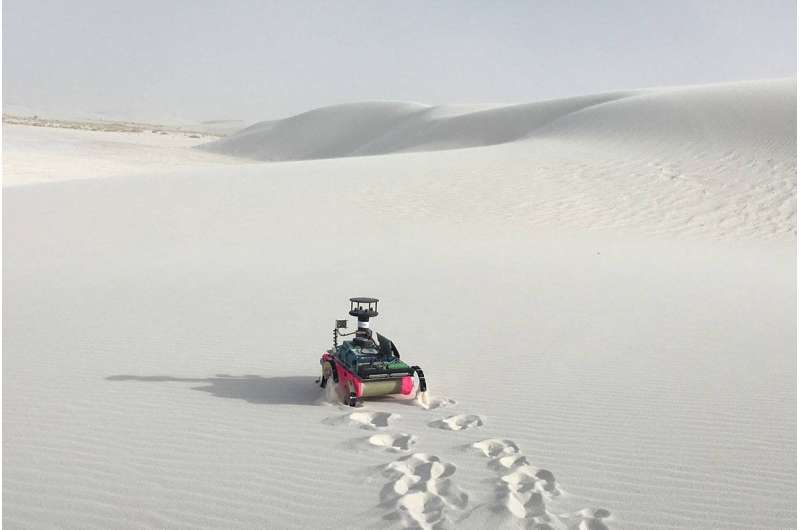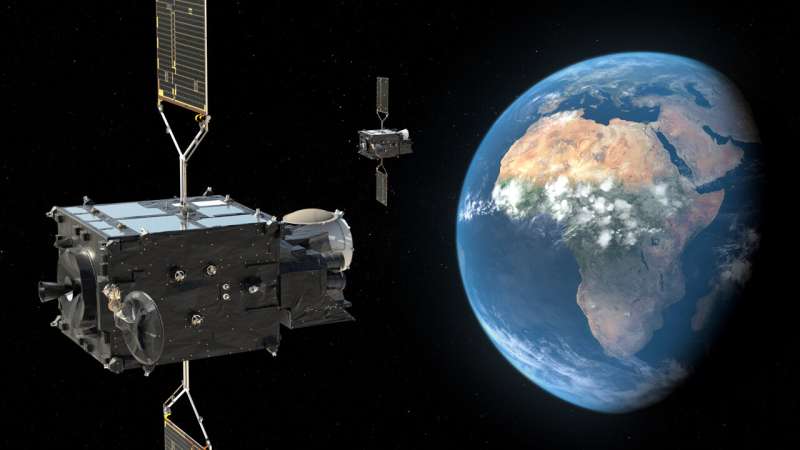
Copernical Team
SpaceX launches 34 more Starlink satellites, AST SpaceMobile satellite
 Elon Musk's SpaceX launched 34 more Starlink satellites with AST SpaceMobile's BlueWalker 3 satellite to low-Earth orbit on Saturday.
The satellites were launched by a two-stage Falcon 9 rocket from Launch Complex 39A at Kennedy Space Center in Florida after targeting a 9:20 p.m. liftoff due to weather.
The first stage of the Falcon 9 rocket landed on the A Shortfall of Gravitas
Elon Musk's SpaceX launched 34 more Starlink satellites with AST SpaceMobile's BlueWalker 3 satellite to low-Earth orbit on Saturday.
The satellites were launched by a two-stage Falcon 9 rocket from Launch Complex 39A at Kennedy Space Center in Florida after targeting a 9:20 p.m. liftoff due to weather.
The first stage of the Falcon 9 rocket landed on the A Shortfall of Gravitas New mineral found by Chinese scientists
 Chinese scientists have achieved a remarkable new feat in their research of the moon as they have discovered and identified the sixth new lunar mineral.
The China National Space Administration and the China Atomic Energy Authority jointly announced in Beijing on Friday that the new mineral-Changesite-(Y)-was found by scientists at the Beijing Research Institute of Uranium Geology from surf
Chinese scientists have achieved a remarkable new feat in their research of the moon as they have discovered and identified the sixth new lunar mineral.
The China National Space Administration and the China Atomic Energy Authority jointly announced in Beijing on Friday that the new mineral-Changesite-(Y)-was found by scientists at the Beijing Research Institute of Uranium Geology from surf LeoLabs awarded contract from US Dept of Commerce to support space traffic management prototype
 LeoLabs, Inc., the world's leading commercial provider of low Earth orbit (LEO) mapping and Space Situational Awareness (SSA) services, has announced an award to provide data and services to the US Department of Commerce to support the development of a US civil- led Space Traffic Management (STM) system. The announcement was made at the 9th session of the National Space Council in Houston, Texas
LeoLabs, Inc., the world's leading commercial provider of low Earth orbit (LEO) mapping and Space Situational Awareness (SSA) services, has announced an award to provide data and services to the US Department of Commerce to support the development of a US civil- led Space Traffic Management (STM) system. The announcement was made at the 9th session of the National Space Council in Houston, Texas NASA's Webb catches Tarantula Nebula

A stellar nursery nicknamed the Tarantula Nebula has been captured in crisp detail by NASA's Webb telescope, revealing hitherto unseen features that deepen scientific understanding, the agency said Tuesday.
Officially known as 30 Doradus, the region of space is characterized by its dusty filaments that resemble the legs of a hairy spider, and has long been a favorite for astronomers interested in star formation.
Thousands of young stars, distant background galaxies, and the detailed structure of the nebula's gas and dust structures were viewable for the first time thanks to Webb's high resolution infrared instruments.
Why go back to the Moon?

On September 12, 1962, then US president John F Kennedy informed the public of his plan to put a man on the Moon by the end of the decade.
It was the height of the Cold War and America needed a big victory to demonstrate its space superiority after the Soviet Union had launched the first satellite and put the first man in orbit.
"We choose to go to the Moon," Kennedy told 40,000 people at Rice University, "because that challenge is one that we are willing to accept, one we are unwilling to postpone, and one which we intend to win."
Sixty years on, the United States is about to launch the first mission of its return program to the Moon, Artemis. But why repeat what has already been done?
Criticism has risen in recent years, for example from Apollo 11 astronaut Michael Collins, and the Mars Society founder Robert Zubrin, who have long advocated for America to go directly to Mars.
Walking robots could aid research on other planets

Today NASA uses wheeled rovers to navigate the surface of Mars and conduct planetary science, but research involving Texas A&M University scientists will test the feasibility of new surface-exploration technology: walking robots.
Ryan Ewing, Robert R. Berg Professor in the Department of Geology and Geophysics at Texas A&M, and Marion Nachon, associate research scientist in geology and geophysics, are co-investigators on the project supported by NASA and led by Feifei Qian, a WiSE Gabilan Assistant Professor at the University of Southern California Viterbi School of Engineering. The aim of the research is to create and test walking, or "legged," robots that could more easily glide through icy surfaces, crusted sand and other difficult-to-navigate environments, thus significantly enhancing scientists' abilities to gather information from planetary bodies.
While the Mars Exploration Rovers and other robots have been successfully sent into space, they typically operate based on pre-programmed agendas that require human scientists and engineers to input detailed instructions regarding where to go and what to do prior to the robots' arrival at the planet.
Preparing the MTG-I1 weather satellite for launch

MIT students contribute to success of historic fusion experiment
 For more than half a century, researchers around the world have been engaged in attempts to achieve fusion ignition in a laboratory, a grand challenge of the 21st century. The High-Energy-Density Physics (HEDP) group at MIT's Plasma Science and Fusion Center has focused on an approach called inertial confinement fusion (ICF), which uses lasers to implode a pellet of fuel in a quest for ignition.
For more than half a century, researchers around the world have been engaged in attempts to achieve fusion ignition in a laboratory, a grand challenge of the 21st century. The High-Energy-Density Physics (HEDP) group at MIT's Plasma Science and Fusion Center has focused on an approach called inertial confinement fusion (ICF), which uses lasers to implode a pellet of fuel in a quest for ignition. Blue Canyon and SEAKR deliver first flight unit and payloads for Blackjack Program
 Small satellite manufacturer and mission services provider Blue Canyon Technologies, LLC, and SEAKR Engineering, LLC, wholly owned subsidiaries of Raytheon Technologies, has announced that they have delivered one Saturn-class microsat bus and completed acceptance testing of the first two of twelve Pit Boss Battle Management Command, Control and Communication payloads for the Defense Advanced Res
Small satellite manufacturer and mission services provider Blue Canyon Technologies, LLC, and SEAKR Engineering, LLC, wholly owned subsidiaries of Raytheon Technologies, has announced that they have delivered one Saturn-class microsat bus and completed acceptance testing of the first two of twelve Pit Boss Battle Management Command, Control and Communication payloads for the Defense Advanced Res LEO satellite cluster to provide secure digital military intelligence from 2024
 BAE Systems is set to launch its first multi-sensor satellite cluster into low Earth orbit in 2024 to deliver high-quality information and intelligence in real time from space to military customers. Known as AzaleaTM, the group of satellites will use a range of sensors to collect visual, radar and radio frequency (RF) data, which will be analysed by on board machine learning on edge processors t
BAE Systems is set to launch its first multi-sensor satellite cluster into low Earth orbit in 2024 to deliver high-quality information and intelligence in real time from space to military customers. Known as AzaleaTM, the group of satellites will use a range of sensors to collect visual, radar and radio frequency (RF) data, which will be analysed by on board machine learning on edge processors t 
